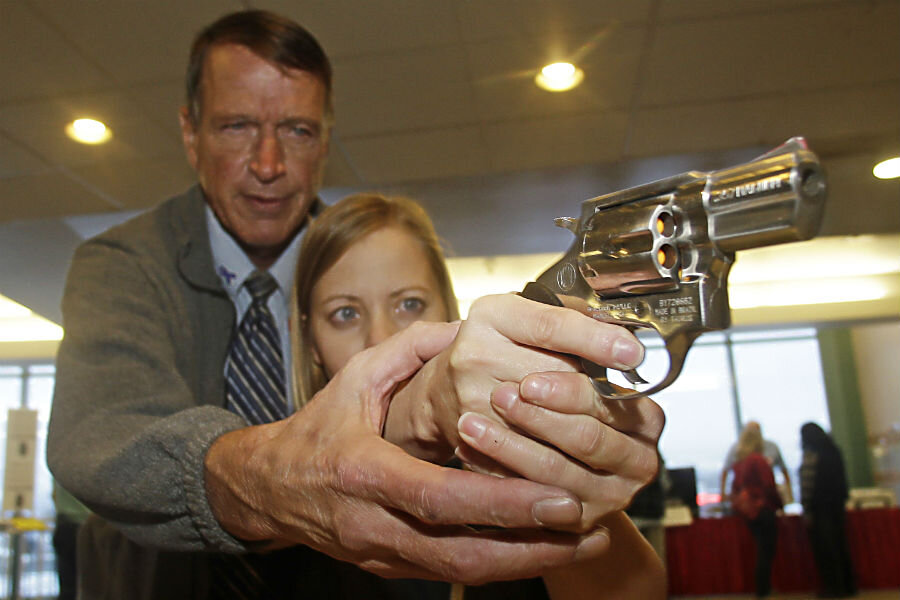Should public schools teach how to use guns? Yes, say South Carolina legislators
Loading...
Should public school students be instructed on firearms?
Absolutely, says a group of South Carolina legislators. They have filed two bills in the South Carolina legislature mandating gun safety courses and Second Amendment-related curricula in state schools, a move designed to target zero-tolerance policies on guns in schools.
One bill, filed by State Rep. Alan Clemmons, would establish a three-week educational unit, for all grade levels, devoted to the US Constitution, focusing on the Second Amendment.
The proposed bill would also establish a Second Amendment Awareness Day to be held on Dec. 15 each year in all state schools, complete with a poster or essay contest centered on the theme “The Right To Bear Arms: One American Right Protecting All Others.”
Rep. Clemmons told South Carolina's The Greenville News that he was inspired to create the bill after hearing the story of a student who was arrested at school over a fictional essay he wrote in which he talked about buying a gun to kill a neighbor’s pet dinosaur.
That sort of zero-tolerance attitude towards guns in schools, Clemmons told a local South Carolina paper, is undermining knowledge of, and respect for, the Second Amendment. “In this case, it squelched a student’s First Amendment rights, in responding to an assignment, to talk about the Second Amendment,” Clemmons told The Greenville News. “We are giving short shrift to the one amendment that protects all others.”
Gun rights and safety education has traditionally not been the purview of public schools, with incidents like the school shooting at Newtown, Conn., hardening many parents' resolve against firearm-related curricula. But proponents argue that the best way to counter school shootings and inappropriate gun use is education. Nonetheless, the bill is controversial.
For starters, its proposed "Second Amendment Awareness Day" is scheduled for Dec. 15, which happens to be the day after the anniversary of the Sandy Hook school shooting, in which a lone gunman fatally shot 20 students and six adults at a Newtown elementary school. Clemmons has said the date is a coincidence and he is open to other dates.
Another point of contention is a clause requiring new gun- and Second Amendment-related curriculum be either created or approved by the National Rifle Association, a gun advocacy group.
Another bill, proposed in the state Senate by Sen. Lee Bright, would allow South Carolina schools to offer elective courses on gun safety, gun rights, and marksmanship. If passed, the bill would allow schools to bus students off-campus to gun ranges, where they would learn about gun safety as well as how to use guns.
According to the Greenville News, Sen. Bright likened the gun safety courses to driver’s education courses now offered by schools.
It's not the first time gun-rights proponents have advocated for firearms in schools, or firearm education. Since the shooting at Sandy Hook Elementary School, most schools have evaluated their emergency procedures. The result: a small but growing group of US school districts has argued that arming teachers and staff is the best way to protect its students.
A small school district in Arkansas began arming 20 volunteer teachers and staff with handguns last fall, under a state law that allows licensed, armed security guards on campus. It is the first in the state to do so.
As The Christian Science Monitor reported last year: "In 2013, seven states passed legislation permitting teachers or administrators to carry guns in schools and more than 30 state legislatures introduced bills that would permit staff members to carry guns in public or private schools, according to the National Conference of State Legislatures."
Still, most proposals to arm teachers or staff have failed because insurance companies are refusing to provide coverage to schools that allow handguns on campus.
Introducing legislation that allows or mandates firearm-related curricula, as legislators in South Carolina are proposing, however, offers gun-rights proponents an alternative, firearm-friendly, means by which to counter shootings. Nonetheless, these two proposals have a long way to go before potentially becoming state law.








